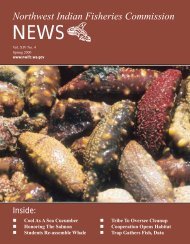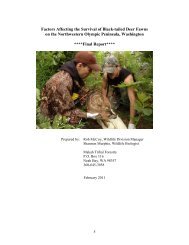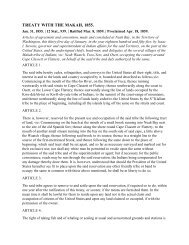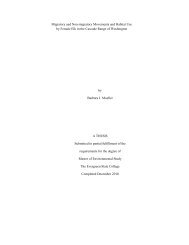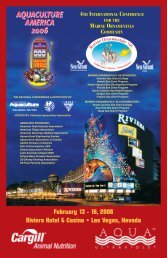DIET, NUTRITION, AND REPRODUCTIVE ... - NWIFC Access
DIET, NUTRITION, AND REPRODUCTIVE ... - NWIFC Access
DIET, NUTRITION, AND REPRODUCTIVE ... - NWIFC Access
Create successful ePaper yourself
Turn your PDF publications into a flip-book with our unique Google optimized e-Paper software.
20<br />
and forbs were taken from just above ground, shrubs were collected as leaves and twigs,<br />
ferns were collected as 75% of frond, conifers were collected as new or young growth.<br />
This collection method reflected observer bias, and may not accurately reflect elk<br />
selection of particular plants or plant parts. Grazing animals are known to select forage<br />
higher in quality than what is available (Van Dyne et al. 1980), whereas I collected plant<br />
samples from random plants at a foraging location. All plant samples were air dried (18-<br />
22 o C) for 2 to 5 days until brittle, and stored in paper bags.<br />
A subset of the collected plant samples was selected for nutritional analysis. The<br />
selection of the subset of plant samples was based on the diet results from fecal analysis.<br />
Every forage plant species found in the diet could not be analyzed. Two criteria were<br />
used to reduce the list of plant species to a feasible number of plants (6 to 7) for each<br />
sampling period. First, I selected the three or four plant species that made up the greatest<br />
percentage of the diet across all herds for each sampling period. Second, I selected three<br />
or four plant species that made up the greatest percent of the diet for only a few herds for<br />
each sampling period. Combining these two criteria I attempted to analyze the three<br />
plant species that made up the greatest percentage of each herds’ diet for each sampling<br />
period.<br />
Each plant species was analyzed for crude protein, in-vitro dry matter digestibility<br />
(hereafter digestibility), and gross available energy. All plants were ground to 1 mm<br />
screen size in a Wiley Mill (Model 3383L20, Thomas Scientific, Swedesboro, NJ). The<br />
Wildlife Nutrition Lab at Washington State University completed the dry-weight protein<br />
(Kjeldahl method) and digestibility analysis (Tilley and Terry 1963). Laboratory analysis



